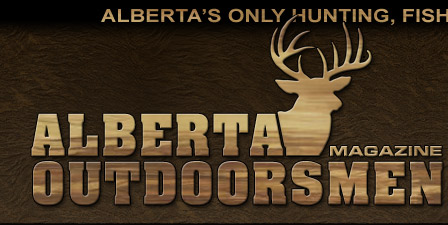|
 |
 |
I worked my way over the deadfall that lay hidden beneath the tall, yellow grass of the small opening. Four inches of fresh wet snow made the deadfall slippery and foot placement had to be chosen carefully for fear of a sudden slip and a wet backside, or worse.
My destination was Secret Ridge, a newly named deer trail that lay along the top of a long sweeping ridge. Poplar is the prevalent tree on top, interspersed with the odd spruce while the slope of the ridge is reverse of that. The trail was definitely out-of-the-way and I was confident I would be the only one watching it.
Hunting partner Ken Marlatt and I had discovered the trail while investigating the opening and we were immediately impressed with the traffic. Tracks were heavy in the fresh snow while scrapes and rubs adorned the area around and under each spruce tree—this was definite whitetail country.
I removed the trail camera I had slung over my shoulder and began the process of placing it on a poplar tree that stood just a few feet from the edge of the ridge. I needed to see what was using the trail; perhaps employing the use of a ground blind if the camera deemed it worthwhile.
 |
| Without a trail camera, the author never would have known this deer was in the area he was hunting. |
Two weeks earlier I had announced to my hunting partners that I was finished with putting up trail cameras and that I was just going to hunt this year... period. No chasing trail cameras all over the country when I should be hunting. But here I was, now with six Treebark Trail Cameras up and running and one more to find a location for; I just couldn’t help myself.
Trail cameras allow us to discover what is in the area we are hunting, perhaps giving us the opportunity to hunt a bigger deer because we know he’s there, when otherwise we may not have known.
But they also help us understand how deer react to or work a scrape; giving us a chance to see how bucks and does interact during the rut period and at other times throughout the year.
And there is always a chance for a surprise photo; I have captured images of everything from a turkey vulture to a lynx and a fisher. The possibility of amazing photos is certainly within reach.
But not everybody is sold on trail cameras and many believe they are unethical, bordering on the wrong side of the fair chase principle. And with the advent of trail cameras that can send images via cell phone coverage the moment an image is captured, these people may have a good argument.
And some states have already adopted trail camera laws, including Montana, who have a policy where the use of trail cameras is prohibited during an open hunting season.
From the 2011 Montana Hunting Regulations: “It is illegal for a person to possess or use in the field any electronic or camera device whose purpose is to scout the location of game animals or relay the information on a game animal’s location or movement during any Commission adopted hunting season.”
There is no doubt that the next wave of electronic surveillance devices is already here. Just Google “cellular trail cameras” and see what you get.
According to Alberta’s Provincial Big Game Specialist, Rob Corrigan, the man responsible for our hunting and trapping regulations and seeing them through the regulatory process, technology is certainly difficult to keep up with.
“We struggle with the technological aspects of hunting,” says Corrigan. “Just look at how far compound bows have come over the last twenty years. If we knew then what we know now, our archery seasons certainly wouldn’t be as liberal as they are now.”
Many, including Montana Fish, Wildlife & Parks officials, feel that technology is “taking the ethics out of hunting and damaging the spirit of fair chase.”
However, others believe Montana has overstepped their bounds. Even if trail cameras raise concerns over ethics, should a government department be making such a decision based on ethics, or should they be sticking to science and game management?
Or perhaps the use of trail cameras while hunting is an unfair advantage and they should be controlled as part of the game management toolbox.
Trail cameras that have the ability to send images using cell phone coverage would be of little use if you were sitting at home or at your desk at work. But what if you were just a short distance away and you received an image on your cell phone of a large buck headed your way? Would that not be similar to the current law that disallows “…communicating, for the purpose of hunting, the signs or whereabouts of wildlife seen during a flight on an aircraft.”
Could an argument not be easily made that these types of devices do in fact border on the wrong side of the fair chase principle?
“A lot of this stuff comes down to personal ethics,” said Corrigan, who doesn’t use trail cameras himself when hunting. He also has no concerns over the use of standard trail cameras, but those that send photos directly to a hunter in the field, may be something that has to be looked at.
“Our enforcement guys are always bringing this type of stuff to our attention,” said Corrigan. “But it’s still very hard to chase technology.”
And that’s where the problem may lie. Advances in hunting equipment have divided hunters on many fronts and often the advantage is put squarely in the hunter’s lap, but maybe none has gone so far as cellular trail cameras.
It’s one thing to know there is an animal in your area, it’s entirely different to know exactly where at a given moment. ■
For previous Outdoor Pursuits click here.
|
|
|
|


